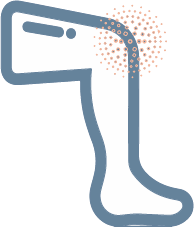Juvenile Idiopathic Arthritis Precision Panel
Juvenile arthritis is a heterogenous group of inflammatory arthritis of unknown etiology, all defined by the presence of at least one inflamed joint persisting more than six weeks.


Juvenile arthritis is a heterogenous group of inflammatory arthritis of unknown etiology, all defined by the presence of at least one inflamed joint persisting more than six weeks. Juvenile Idiopathic Arthritis (JIA) is the most common rheumatic disease in children, with an unpredictable clinical course and the impending risk of impaired joint function. It begins before 16 years of age, and the triggering factor can be a trauma or infection. JIA can be classified in six categories:
Systemic arthritis
Polyarthritis (rheumatoid factor positive or negative)
Oligoarthritis
Enthesitis-related arthritis
Psoriatic arthritis
Undifferentiated arthritis
The prognosis varies depending on the case, but systemic arthritis and rheumatoid factor positive polyarthritis generally show a worse prognosis. The most common mode of inheritance is autosomal recessive.
The Igenomix Juvenile Idiopathic Arthritis Precision Panel can be used to make an accurate and directed diagnosis as well as a differential diagnosis of arthritis ultimately leading to a better management and prognosis of the disease. It provides a comprehensive analysis of the genes involved in this disease using next-generation sequencing (NGS) to fully understand the spectrum of relevant genes involved.
The clinical utility of this panel is:
Prakken, B., Albani, S., & Martini, A. (2011). Juvenile idiopathic arthritis. Lancet (London, England), 377(9783), 2138–2149.
Smolen, J. S., Landewé, R., Bijlsma, J., Burmester, G. R., Dougados, M., Kerschbaumer, A., McInnes, I. B., Sepriano, A., van Vollenhoven, R. F., de Wit, M., Aletaha, D., Aringer, M., Askling, J., Balsa, A., Boers, M., den Broeder, A. A., Buch, M. H., Buttgereit, F., Caporali, R., Cardiel, M. H., … van der Heijde, D. (2020). EULAR recommendations for the management of rheumatoid arthritis with synthetic and biological disease-modifying antirheumatic drugs: 2019 update. Annals of the rheumatic diseases, 79(6), 685–699.
Siegel, P., Tencza, M., Apodaca, B., & Poole, J. L. (2017). Effectiveness of Occupational Therapy Interventions for Adults With Rheumatoid Arthritis: A Systematic Review. The American journal of occupational therapy: official publication of the American Occupational Therapy Association, 71(1), 7101180050p1–7101180050p11.
Thatayatikom, A., & De Leucio, A. (2020). Juvenile Idiopathic Arthritis. In StatPearls. StatPearls Publishing.
Eng, S. W., Duong, T. T., Rosenberg, A. M., Morris, Q., Yeung, R. S., & REACCH OUT and BBOP Research Consortia (2014). The biologic basis of clinical heterogeneity in juvenile idiopathic arthritis. Arthritis & rheumatology (Hoboken, N.J.), 66(12), 3463–3475.